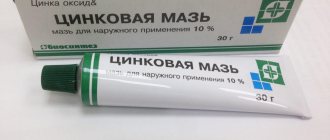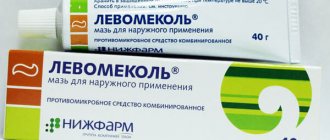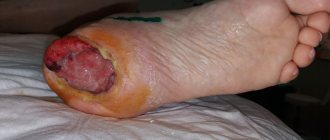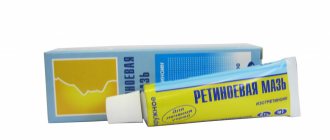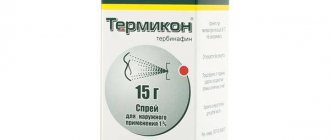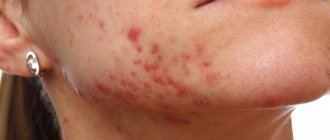Zinc ointment is one of the best remedies in the fight against diaper rash, excessive sweating and acne. It provides the necessary skin care, disinfecting and protecting from external adverse factors. The low price makes it accessible to consumers, and the low percentage of allergic reactions gives it the right to be called safe for babies.
How to use zinc ointment
Zinc ointment is used in pediatrics as a protective agent against diaper rash. In addition, it is recommended to lubricate the baby's delicate skin under the diaper every time after bathing. Zinc creates a reliable barrier that protects children's skin from constant contact with urine and loose stool. By applying zinc ointment to the buttocks daily, you can protect your baby from diaper dermatitis.
The disinfecting effect of the drug is used when treating wounds. By applying the composition to abrasions, you can avoid infection, prevent acidification of the damaged surface, and speed up the process of skin regeneration.
The main indications are:
- diaper rash;
- scratches;
- dermatitis;
- eczema;
- cuts.
In addition, zinc ointment is used to care for the elderly and immobile patients. Treatment of bedsores slows down their spread and disinfects, which eliminates the risk of secondary infections.
Diaper rash in infants: treatment and prevention
13.12.2021
The skin of a newborn baby is extremely sensitive, and the most susceptible to irritation is the area of the diaper, which is inaccessible to air and is also constantly wet, and contact with irritating chemicals in urine and stool, as well as friction of the diaper on the skin, becomes a prerequisite for the appearance of diaper rash in the area of the baby’s buttocks.
The lipid protective layer of a baby's skin is not yet fully formed, so irritation, chafing and dermatitis . Any redness noticed should be alarming, as it can quickly progress to diaper rash or diaper rash .
Diaper dermatitis is characterized by the appearance of skin rashes in places where the diaper fits tightly - most often the buttocks, groin, genital , lower abdomen . The first symptoms are erythema and peeling of the epidermis; in subsequent stages, red spots, papules, blisters or erosions appear. The child becomes irritable, whiny and nervous.
Diaper rash in newborns and infants most often occurs as a result of wet skin under the diaper and too much skin contact with urine or feces. Sensitive skin is irritated by ammonia produced when bacteria decompose. When the skin is damaged and inflammation develops as a result of irritants, secondary fungal (especially yeast) or bacterial infections often occur. Under the influence of bacteria, urine becomes more alkaline, which further increases its irritating effect on the skin, and an increase in pH promotes the further development of bacteria. The risk of diaper rash in a newborn is higher when the environment is hot (summer). In addition, the appearance of diaper rash in children is facilitated by a predisposition to an allergic reaction , for example, to the material of the diaper or certain substances used to care or treat this area, as well as the use of low-quality diapers.
Factors contributing to the formation of diaper rash
- Not changing diapers often enough
- use of unsuitable baby skin care products
- using excessive amounts of creams and powders
- infrequent washing and airing of the baby’s buttocks
- unsuitable irritants used for washing diapers
- changes in stool composition due to food changes or antibiotic therapy
- heat
- skin is prone to allergies
What does diaper rash look like in babies?
The first thing parents notice when changing a diaper is redness of the skin around the anus , intimate areas or groin. Redness may be accompanied by swelling and the release of serous fluid. The skin is warmer and very sensitive to touch. The baby is restless, experiencing discomfort, burning and pain.
Diaper rash in children can lead to bacterial and fungal dermatitis . In just a few hours, if not noticed or taken care of properly, diaper rash can turn into dermatitis . Its symptoms:
- no improvement in the condition of the child’s skin
- the rash enlarges and extends beyond the diaper
- peeling skin
- temperature increase
Airing is the best way to get rid of diaper rash. It is necessary to remove the diaper and allow the child to lie naked for as long as possible (a few hours a day, but shorter times will also be beneficial). Of course, this procedure is easier to perform if the child is not yet very actively moving and does not change position on his own, because such a baby just needs to be placed on a sanitary pad or a folded diaper - thanks to this, you can avoid staining the blanket or bed linen. The best time to ventilate the buttocks is when the baby has just had a bowel movement.
What will speed up the fight against diaper rash?
It is definitely worth using water instead of napkins - clean, without soap (and if you cannot do without soap, at least it should be soap intended for babies). Washing your baby's skin too often or too aggressively with soap or wearing diapers that are too small (or too tight) will result in insufficient air flow. As a result, the problem only gets worse.
Diaper rash ointment for babies can be applied to irritated skin. Effective ointments that prevent the penetration of urea into the skin include: zinc ointment, petroleum jelly. Before applying any product, it is important to thoroughly cleanse the skin and then dry it.
Potato flour is also good for rubs. It also has three additional advantages: firstly, it is completely natural and does not contain any chemicals, secondly, it is cheap, and thirdly, it is easily available. The use of talc-based powders is not recommended.
Babies with allergies , a hereditary tendency to diaper rash, a pH imbalance (improper balance between acidity and alkalinity), or babies with higher than normal levels of ammonia in their urine are especially prone to a recurrence of this condition. Once irritated and at the same time extremely sensitive, a child’s skin is more prone to subsequent relapses.
Published in Pediatrics Premium Clinic
How does zinc ointment work on acne?
Use in cosmetology has shown its effectiveness against acne. Skin rashes caused by excessive secretion from the sebaceous glands may disappear if zinc ointment is used correctly:
- Cleanse skin of makeup and impurities.
- Wipe skin dry.
- Apply zinc ointment to the area affected by acne.
- Leave overnight.
Zinc will dry out areas of the skin and prevent the sebaceous glands from producing sebum.
Do I need to wash off zinc ointment from my face?
The constant presence of zinc on the skin of the face can lead to dryness and flaking. However, this depends on the individual characteristics of the sebaceous glands. If pathological activity is noted, the zinc ointment may not be washed off, but in this case there is no need to apply foundation and other cosmetics on top of it: firstly, this will clog the pores, and secondly, the compositions of some products may react with zinc, which may lead to chemical reactions between components.
If the ointment is not washed off during the day, be sure to cleanse the skin by washing before the next application. Otherwise, the accumulation of daytime dust in the pores with ointment residues can give rise to a new skin problem.
Herpes: what is it and what medications to use?
Herpes means “crawling” in Greek. At the moment, the relevance of this disease has not decreased. It occurs in more than 90% of the population.
What is herpes
Most often, problems are caused by herpes simplex virus types 1 and 2. Type 1 is herpes on the lips, eyes and mouth. Type 2 is genital herpes and herpes of pregnant women and newborns.
How to understand that it is herpes?
Let's take for example the most commonplace herpes on the lips. The first thing a person feels is itching in the lip area (often it may not be noticed during the day). On the same day, redness and red spots appear. The next day, a blister and swelling appear at the site of redness. After 3-5 days, a crust forms at the site of the burst blisters. After 7-9 days, all symptoms disappear. Also, during the stage with blisters, the temperature may rise to 37.5-38.5°C and pain may appear.
But to reliably confirm the diagnosis, a blood test is required to determine the presence of a specific reaction of the body to the virus (IgM); it will indicate that at the time of donating blood you are experiencing an acute period of illness.
For genital herpes, discharge from the genital tract and urethra is also taken for examination. Consultation with a specialist (dermatovenerologist) is required.
It is worth noting that the virus is not eliminated from the body after chickenpox, but remains to “live” in a certain part of our nervous system, so taking an Ig G test does not make sense.
How can you get infected?
Infection occurs through mucous membranes:
- lips
- Rta
- Nose
- Genitals
- Eyes
- Through the skin in contact with biological fluids (saliva, urine, semen, tears, nasal discharge, direct fluid from the herpes vesicle).
That is, most often infection occurs due to poor hygiene and protection during sexual intercourse. Also, when scratching the blisters that have already appeared, they spread to new areas of the skin and mucous membranes.
A separate route of infection from mother to fetus, currently testing for HSV-1.2 is mandatory in women planning pregnancy and pregnant women.
The infection affects the nervous system and has dangerous consequences for the body.
How to behave with herpes
- Do not touch the rash with your hands; if you touch it, wash your hands immediately.
- Use separate dishes, cosmetics, and towels.
- Refrain from kissing and sexual contact.
- Apply medicated gels and ointments with a cotton swab, not with your hands.
Be sure to treat!
To reliably confirm the diagnosis, it is necessary to undergo an analysis.
Drugs
Let us consider in detail the groups of drugs for treatment
- Antiviral:
- Zovirax
- Valtrex
- Famvir
- Groprinosin
This group of drugs acts directly on the cause, the virus itself. The course and dosage regimen are prescribed by the doctor after a comprehensive examination.
The drugs are well tolerated; they are contraindicated during pregnancy and breastfeeding. Use with caution and under medical supervision in persons with renal and hepatic insufficiency. For children, the dose is determined by the pediatrician based on weight.
2. Interferon preparations:
- Viferon
- Kipferon
- Reaferon EC lipint
When you get a herpes infection, there is a decrease in the production of your own interferon alpha, which means a decrease in the body's defenses against the virus.
This group has practically no contraindications. It is the main method of treating such a vulnerable group as pregnant and lactating women.
- Interferon inducers:
- Amiksin
- Cycloferon
- Anaferon
Used to stimulate the production of your own interferon and avoid aggravation of the course and spread of infection. Well tolerated. Contraindications for each drug are for a certain age indicated in the instructions.
- Local antibacterial and antiviral drugs:
- Grammidin
- Lysobacter
- Hexoral
These drugs are used for herpetic lesions of the oral mucosa, have an antibacterial, antiviral effect, and also relieve inflammation and relieve pain.
- Zovirax ointment and Zovirax Duo active
- Viferon
- Infagel
- Panavir
They have a local antiviral effect, Zovirax Duo Active in combination with the hormone hydrocortisone provides rapid relief from inflammation and, accordingly, pain, and also prevents the formation of new blisters. But since it contains a hormonal component, you need to read the instructions very carefully. Only from 12 years old. Before using any ointments and gels, it is necessary to cleanse the skin of cosmetics and impurities.
- Immunomodulators under the control of an immunogram:
- Polyoxidonium
- Lycopid
Only under the supervision of an immunologist.
- Painkillers:
- Nurofen
- Panadol
Relieves pain, inflammation and, if necessary, temperature.
- Antihistamines:
- Zodak
- Claritin
Helps avoid swelling.
- Vitamin complexes:
- Vitrum
- Complivit
- Selenium
- Zinc
- Vitamin C
You can also separately select a vaccine against herpes. It is indicated for adults who suffer from herpes more than 3 times a year and a high titer of antibodies, elderly people, and HIV-infected people. Also for children who have not had chickenpox.
Treatment for pregnant women is selected depending on the duration of pregnancy, strictly by an obstetrician-gynecologist and depends on the severity of the course!
Herpes is a complex problem. The cause of recurring or new herpes is a decrease in immunity and hormonal changes.
The main prevention is to maintain the functioning of the immune system:
- Complete nutrition
- Sufficient amount of meat, fish and vegetables.
- Taking complex vitamin preparations containing necessarily: zinc, vitamin A, E, C.
- It is necessary to monitor the level of iron in the blood.
- The largest organ of our immune system is the intestines; it is necessary to support its functioning and, if necessary, take pro- and prebiotics.
- Have a regular sexual partner and observe good hygiene.
- In case of frequent recurrence of infection, vaccinate during periods of “quiet” periods.
- People with systemic diseases (diabetes mellitus types 1, 2, etc.) need to control and maintain the underlying disease in the compensation stage.
Literature:
Federal clinical guidelines for the management of patients with genital herpes - Moscow 2015; Clinical guidelines for herpes simplex in adults - 2014;
Radar Directory
Contraindications
The ointment is not used to treat skin diseases in patients prone to allergic reactions to the components of the drug.
Zinc ointment is not applied to the mucous membranes of the mouth. Once zinc enters the bloodstream through the esophagus, it can cause poisoning, which can lead to convulsions, allergic skin reactions, nausea, vomiting and dizziness. Exceptions may be the mucous membranes of the anal ring and foreskin, where the ointment can be applied to relieve the inflammatory process, accelerate the healing of cracks and disinfect the surface.
How to use zinc ointment for sweat
Excessive sweating is a problem that zinc ointment helps combat. Violation of the function of thermoregulation leads to excessive production of sweat by the glands, due to which the body tries to reduce body temperature. Zinc ointment does not affect the center of thermoregulation, however, it can reduce the activity of the sweat glands, thereby reducing the amount of sweat produced.
It should be noted that the sweat produced by humans is odorless. The waste products of bacteria that multiply in the armpits, which contain a favorable environment for the proliferation of microorganisms, smell. Zinc ointment, having an antiseptic effect, reduces the rate of bacterial growth, thereby eliminating unpleasant odors.
The difference between salicylic-zinc paste and salicylic ointment
The difference between external agents lies in the composition and intended use. The components form a paste, the purpose of which is the drying and antimicrobial effect of zinc and fat. acids. Therefore, the area of application of the product is primarily a pathological skin process, accompanied by active inflammation and weeping.
The paste is used for microbial and other types of eczema in the initial stages of its development, as well as for exudative psoriasis, various types of dermatitis, and excessive sweating of the skin of the feet. The product simultaneously dries and has an antiseptic effect, while dissolving crusts and scales.
Salicylic ointment consists only of salo. acid dissolved in a fat base. It does not have a drying effect, therefore, in case of weeping processes on the skin, it is not prescribed, unlike a paste. The product is used to dissolve hardened calluses, the upper layer of warts, followed by their removal, in order to remove psoriatic crusts. Also used for long-term eczema to soften dry skin and heal it.
What to choose?
When choosing between zinc ointment or salicylic-zinc paste for the treatment of psoriasis or eczema, preference is given to ointments if the skin is dry, crusty and flaky. The paste is suitable for chronic dermatoses accompanied by excessive exudation and inflammation.
To combat problem skin, as well as diaper rash, and prickly heat, a paste with zinc oxide is ideal. Acne is a reason to use a combination mash. A large number of acne requires the use of both acid and zinc.
If it is necessary to remove corns and warts, 5% salicylic ointment will best dissolve the rough layer, which will help remove formations on the skin more efficiently. Wart removal products will work more effectively if the keratinized epithelium is first removed.
Both forms are inexpensive means for external use.

